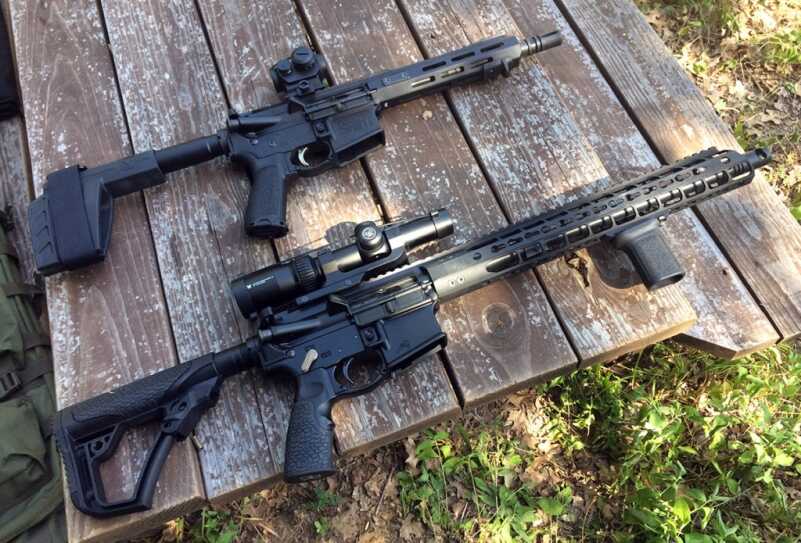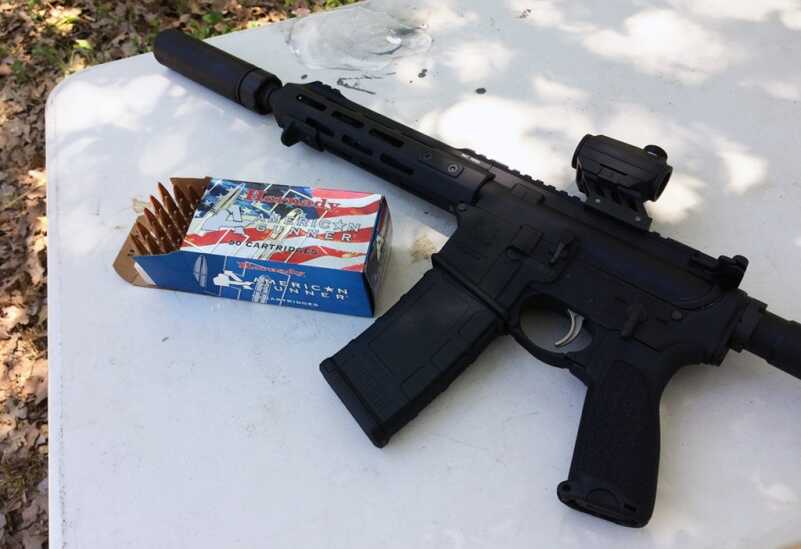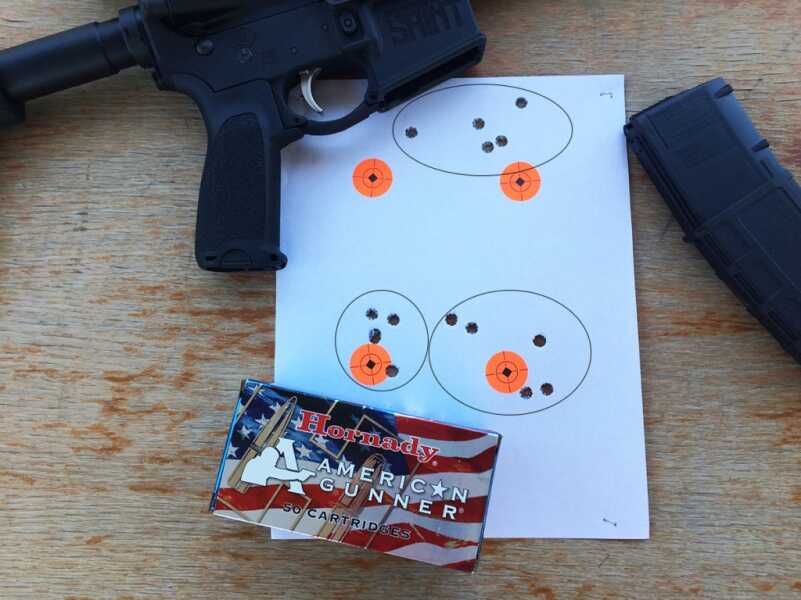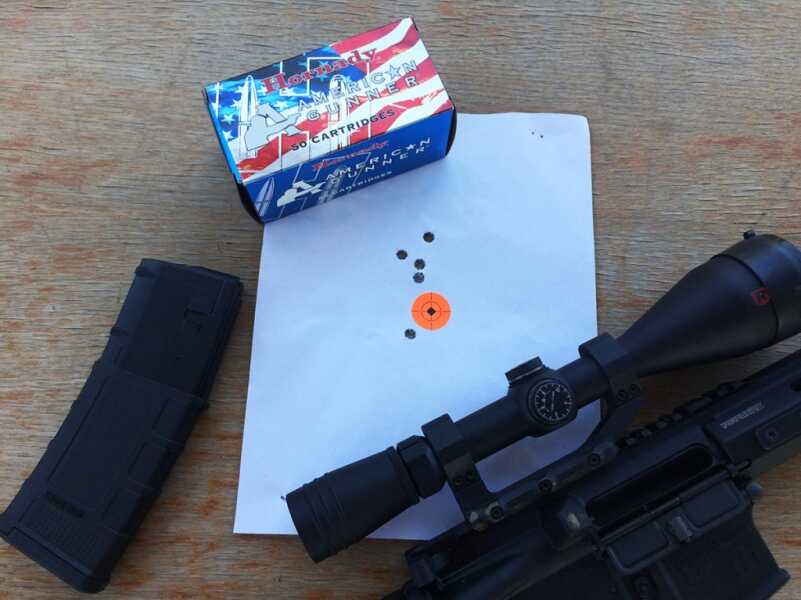Size matters, but when it comes to combat-ready firearms, smaller is often better. Compact weapons allow for easy maneuvering in tight spaces, which is an especially useful attribute in a home-defense firearm. Now, thanks to a favorable ruling from the ATF, Springfield has introduced two pistol-length versions of their popular Saint AR-15: the .556 and, more recently, a 300 Blackout model.
I got a chance to test the 300 Blackout soon after it was released, and I have to say, I was impressed.
First, for those who haven’t been keeping up with the ATF’s schizophrenic decrees…
How Is This Legal? Don’t Short-Barreled Rifles Require a Tax Stamp?
I’m not a lawyer, but that’s never stopped me from offering legal advice, so here goes.
(Just kidding, please don’t sue me).
The ATF released in 2015 an open letter stating that the use of a pistol brace (like the one affixed to the Saint) to shoulder a firearm constitutes a “redesign” and is therefore illegal unless the user has purchased a $200 tax stamp. Then, to the great rejoicing of 300 Blackout fans everywhere, the feds reversed their position, stating in another letter that “an NFA firearm has not necessarily been made … even if the attached firearm happens to be fired from the shoulder.”
So, yes, right now the Saint Pistol is perfectly legal, as long as you don’t “take affirmative steps to configure the device for use as a shoulder-stock” (e.g., permanently affix the brace to the end of a buffer tube, remove the arm-strap, or otherwise undermine its ability to be used as a brace). The ATF might (re)reverse their decision at some point down the line, but if that happens you’ll just have to bite the bullet and apply for the tax stamp or shoot the pistol like an actual pistol.
The Springfield Saint uses the low-profile SB Tactical SBX-K brace, a shorter version of the original SBX. The rubber flaps provide decent recoil control, and they’re stiff enough to keep from folding during use. The Velcro strap is somewhat abrasive, but using a raised red dot doesn’t require the kind of low cheek weld necessary on a hunting rifle, for example. I generally run my AR’s with a longer length of pull, but the fixed brace is in keeping with the Saint’s compact design, and it didn’t present any real usage issues.
300 Blackout?
I won’t get into the weeds, but if you’re still unfamiliar with this adaptable little round, you should know a few things. The 300 Blackout uses a shortened and necked-up 5.56 case and a .30 caliber bullet. AR-15 junkies like this round because converting from 5.56 to 300 Blackout just requires a barrel swap—bolt, mag, upper, and lower can all stay the same.

Hornady sent three rounds for use in this review — two subsonic (left, middle) and one supersonic (right).
300 Blackout is also one of the most versatile cartridges on the market. You can find supersonic loads using 110 grain bullets (> 2400 fps) as well as subsonic loads using 225 grain bullets (< 1000 fps). Users can match bullet weight to the application and tailor their rounds to hunt pigs in the brush or reach out to targets at 200+ yards. If you reload, the options are almost literally endless.
With so much variation in bullet weight and muzzle velocity, reliable cycling can sometimes be an issue, especially when using a suppressor. That’s why Springfield included in the Saint Pistol an adjustable gas block, which can be used to tune the rifle to your load/suppressor and ensure reliable cycling. I never had any issues shooting suppressed with either subsonic or supersonic loads, but it’s nice to know that the Saint can be tuned without altering the buffer, spring, or barrel.
Speaking of barrels, 300 Blackout is also ideal for shorter barrels, especially compared to the 5.56. As Clay has explained, 5.56 isn’t the ideal SBR chambering because the tiny round can’t reach maximum, trauma-inducing velocity in barrels under 10 inches. The 300 Blackout, on the other hand, can hit max speeds in 9-inch barrels like the Saint’s.
To test this, I shot three different loads—two subsonic and one supersonic—with the Saint and with a 14.5” AR I built last year. You can see from the table that while the 14.5” produced an extra 100fps with each load, the velocity differences weren’t significant in terms of a percentage of total velocity. Considering the Saint barrel is over 60 percent shorter than my AR, a 7 percent velocity difference isn’t a huge deal.
14.5 Inch
| Brand | Bullet | Average Velocity |
| Hornady | 125g HP | 2186 |
| Hornady | 190g Sub-X | 1095 |
| Hornady | 208g AMAX | 1075 |
Saint 9 Inch
| Brand | Bullet | Average Velocity | Percent Difference |
| Hornady | 125g HP | 2018 | -7.7% |
| Hornady | 190g Sub-X | 1008 | -7.9% |
| Hornady | 208g AMAX | 990 | -7.7% |
In short, if you’ve been holding out on purchasing a 300 Blackout because like microwaves and the Internet, “it’ll never catch on,” there are lots of good reasons to make the Saint your first firearm in this unique caliber.
Features
I am neither a production specialist nor a gunsmith, so I reached out to Springfield to help explain some of the Saint’s more unique features. Before I jump in, here’s the full list:
CALIBER: 300 AAC Blackout
LENGTH: 27.75″
WEIGHT: 5 lbs 9 oz
UPPER RECEIVER: SA Forged Type III Hard Coat Anodized Aircraft Grade 7075 T6 Aluminum w/ Forward Assist
LOWER RECEIVER: SA Forged Type III Hard Coat Anodized Aircraft Grade 7075 T6 Aluminum w/ Accu-Tite™ Tension System
BARREL: 9″ CMV 300BO w/ Melonite® Treatment, 1:7 Twist
GAS SYSTEM: Direct Impingement Pistol-Length Gas Port w/ Adjustable Gas Block
TRIGGERS: A Proprietary, Nickel Boron Coated GI Style
SIGHTS: Not Included
TRIGGER GUARD: Bravo Company
PISTOL GRIP: Bravo Company Mod.3
HANDGUARD: M-Lok Aluminum SA Proprietary T6 Type III Hard Anodized Aluminum
FOREARM BRACE: SB Tactical SBX-K
BUFFER ASSEMBLY: Carbine “H” Heavy Tungsten Buffer
RECEIVER EXTENSION: SA Pistol T6 Type III Hard Coat Anodized Aluminum
CHARGING HANDLE: GI Style
BOLT CARRIER GROUP: Enhanced M16 Melonite® Finish, MPT, 9310 Steel Bolt
MAGAZINE: 1 – 30 Round Magpul PMAG
CASE: Soft Pistol Case
MSRP$989.00
I won’t waste your time re-stating the spec sheet, but I did want to get more details on the propriety features Springfield includes in their pistol. First, the trigger. The trigger group is in a standard GI configuration, but it’s coated in nickel boron.
I spoke with Dave Williams, Springfield’s Research and Development Manager, who explained that nickel boron is a hard, low-friction coating as well as a corrosion inhibitor. The hardness and lubricity make for a smoother and lighter trigger pull while still maintaining GI geometry and spring rates. The trigger on the model I received included the slightest bit of take-up before breaking cleanly at 6-6.5lbs. For a GI trigger, it’s not bad.
The handguard is also notable. Springfield developed the Saint’s M-Lok handguard in-house at the beginning of the Saint rifle project to “provide a more projectionless and rigid handguard anchoring system.” Most handguards use an anchoring system that interferes with the user’s grip at some point along the handguard. Springfield’s version reduces this interference, Williams pointed out, and allows for precise alignment of the Picatinny rails.

Springfield even throws in a PMAG designed specifically for 300 Blackout (though standard AR mags work as well).
Finally, the Saint Pistol features the “Accu-Tite” system, which allows users to tighten the inevitable play between the upper and lower receiver. While loose-fitting receivers don’t totally inhibit accuracy, Williams said that “if the upper shifts during firing it can’t be as accurate as a tighter fitting system, everything else being equal.” The Accu-Tite system uses a tensioning screw between the upper and lower that can be accessed by removing the pistol grip. Springfield isn’t the first to develop this idea, but it’s a nice addition to an already feature-heavy firearm.
Performance
For a firearm like the Saint, dependability is far more crucial than accuracy. Accuracy is important (see below), but a 300 Blackout in a 9-inch barrel isn’t going to be winning any long-range rifle competitions. Springfield designed this rifle (as they mention once or twice in their promo video) for close-quarters gunfighting. It needs to cycle reliably when the burglars break down the front door, not take down a bad guy from 600 yards.
Towards that end, Hornady sent me 400 rounds in three different loads to do everything I could to produce a malfunction. I shot suppressed and non-suppressed. I dumped a few mags and shot for accuracy. I also didn’t clean the gun after taking it out of the included soft case. I just lubed it up and went to work.
The gun jammed once while shooting suppressed, but it occurred the first time I switched from subsonic to supersonic loads. After that, I never experienced any issues with any of the three loads. I was expecting more trouble with the subsonic rounds, as I’ve seen other AR pistols struggle to cycle the super-heavy bullets. But the Saint ate everything I fed it. You’ll want to do more extensive testing with your load of choice if you tap the Saint for home defense, but Springfield’s new offering shows promise.
Shooting the Saint is a blast (*rimshot*). The pistol’s lightweight and compact size allow for quick, easy handling in the standing position. The handguard features a front stop to keep the shooter’s hand from contacting the muzzle device or suppressor, and the Bravo company pistol grip is nicely textured. Subsonic rounds are especially fun. The recoil is minimal, and the report is nearly hearing safe, even with the Dead Air Sandman K I was using. With a larger suppressor, 300 Blackout subs are quiet enough to hear the action cycle.
The handguard heats up after extended shooting sessions, especially with a suppressor. A glove would have solved this problem, but it’s something to keep in mind. And while I wouldn’t say the supersonic rounds are uncomfortable to shoot, the brace’s abrasive strap is most noticeable while firing the 125g. loads.
Accuracy – From 100 Yards
| Brand | Bullet | Average Velocity | Smallest Group | Average Group |
| Hornady | 125g HP | 2018 | 1.37” | 2.23” |
| Hornady | 190g Sub-X | 1008 | 1.59” | 2.49 |
| Hornady | 208g AMAX | 990 | 2.39” | 3.07” |
You can interpret the accuracy chart for yourself, but I was more than satisfied with the Saint’s performance. One hundred yards is the limit for the subsonic rounds, and they’re still hitting center mass with those group sizes. For supersonic loads, two-inch groups are standard.
One of the marks of a high-quality barrel is its ability to retain accuracy even when it begins to heat up. I dumped a few mags to get the barrel good ‘n hot (the technical term) and reshot a group with the 125g. supersonic rounds. The results were excellent.
Conclusion
Compact, reliable, and accurate, the Springfield Saint Pistol in 300 Blackout would make an excellent home defense weapon or truck/car gun. Its diminutive size lets it fit almost anywhere you need it, and its high-quality components mean you can count on it to get the job done. Plus, it’s fun to shoot, so you’ll be much more likely to throw it in your range bag and get some practice.
If you’re in the market for an AR pistol, there’s never been a better time to buy or a better out-of-the-box option than the Springfield Saint.
















“I’m not a lawyer, but that’s never stopped me from offering legal advice, so here goes.” LOVE IT!
why would you register anything?
I have the Saint Victor Pistol in 556 also,man it’s a tack driver love it!so i went and ordered the 300 BLK from my ffl dealer man can’t wait.
I’ll stick with the tavor in .300 blk
Like the saying goes to each it’s own just that simple.
Any time the AR pistol discussion comes up–the inevitable storm und drang of “yes it is–oh no it isn’t” comes up and the legal armchair experts (which includes me ; ) )come out of the woodwork to debate the futility of having a short-barreled AR with something that “sure looks like a stock to me” thus escaping the exquisite pleasure of paying for the $200 annual SBR stamp.
What everyone forgets is that the braced pistol configuration was developed as an assitive device for disabled shooters. Just because something “can” be used in a non-compliant manner (personally, I think the term “illegal” is bandied about way too much in these discussions) doesn’t mean it automatically is–and that is what is behind the interpretation Jordan mentions. The ATF knows it cannot go down the slippery slope of “potential intent” as a way to rule on whether a pistol is really an SBR or not. The inadvertent or accidental shouldering of the buttstock does not repurpose the weapon either. That’s not to say that that is a loophole which allows the weapon to be used in the same way that an SBR is–and people are probably in for trouble if they do that.
Another thing that bears mentioning–because the 300 BO is so easy to shoot with very soft recoil (the only drawback being very loud report in supers unsuppressed). It is quite easy to shoot without any brace or shouldering at all–like anything else, with enough practice–you can get almost as good as an SBR though perhaps not quite as fast. I know I can at least equal those results posted in the article with my unbraced pistol and reddot–and with my 110 black-tipped TAC TX (the ultimate 300 BO super bullet in my experience) handloads get the groups down under 2″–occasionally closer to 1 to 1.5 MOA at 100
Of course there’s some people that’s going to get in trouble while using the stablizing brace, (which by the way is freaken awesome ultra cool fantastic).. Only the people who are in the wrong for doing wrong while using it wrong will cause, make, be and get in trouble and try to blame everything and anybody other than thierselves. They always have, they always will And I like your advise, legal or illegal however you lable it, it’s still just advise. You have a right to give it I have the right to choose to take that advise or not. Why is there always that guy who wants to make someone stop what thier doing if he doesn’t agree. Did anyone ever tell him it’s not an I agree so your right or I don’t agree so your wrong thing? I’m wondering if anyone ever told him not agreeing doesent mean the advise is wrong. It only means that it’s the wrong advise for him. Nothing more nothing less. . .
The 300 BO does not use a bumped up 5.56 case loaded with a 30 caliber bullet. The 300 BO uses a shorten and bumped up 5.56 case to get the correct case OAL.
Thanks, Frank. Good point.
Great article, I have the Saint 5.56 AR Pistol and love it. Thinking of getting the 300 blackout pistol.
Last fall, at a Richmond FFL seminar, the lead attorney for ATF&E, Washington District, stated that legal counsel had assured the bureau that it was not legal for them to state that a device which is legal to manufacture and sell must be used in a certain way. Stated another way, if it is legal to sell a pistol brace, and install it on a firearm, the bureau cannot force the end user to use it in a particular manner. To do otherwise would open the bureau to defeat in the litigation that was almost certain to follow.
Now, I’ve only been dealing with the NFA rules for twenty-five years, but that sounds very much like a reversal of opinion to me…
Sounds to me like the atf was never able to say how people are allowed to use a pistol brace in the first place. But free people do as they please anyway, the atf be damned.
In my comment, I wasn’t intending to make any legal determination one way or another, so I’m sorry if it came out that way. All I was suggesting was that the claim that the ATF reversed its previous determination is inaccurate, based on the grammar and points that I highlighted in the March letter. Whether the brace can be shouldered, or you’re making or redesigning a firearm, wasn’t really the point. If the earlier letter said it’s illegal, there’s nothing in the March letter that specifically reverses that claim. The “RE: Reversal” note at the top refers to the petitioner’s letter to the ATF, not ATF’s evaluation of the March letter that follows. Anyway, thanks for discussing.
It is NOT .556 it is 5.56mm or .223 in reference to necking up the brass case.
Thanks, Joseph. This has been fixed.
I need this gun and the legal problems that can arise from it like I need root canal. I stick with my “Known” legal and registered Bushmaster.
And to re-iterate what the above commenter says, you even call it a stock when talking about the abrasive Velcro strap. To the author of this article…can I just ask you to stop giving legal advice?
Good catch, Jason. Fixed.
Some people are going to get in trouble with this. Even Springfield’s web page shows this firearm being shouldered. I’ve heard this argument a lot, where it’s supposed that the March 2017 clarification letter is somehow a reversal, but that simply isn’t the case. There’s nothing in that letter that reverses the verdict that shouldering the arm brace is illegal, as it pertains to NFA rules around SBRs. The “Reversal” terminology refers so the petitioner’s original request that ATF change their 2015 and Jan 2017 position. However, the letter does not change their position, and reinforces it with more detailed terminology.
PP1: “Since receiving your letter, we have re-examined the conclusions contained in the Open Letter. Although we stand by those conclusions, we agree that the Open Letter may have generated some confusion concerning the analytical framework by which those conclusions were reached. Thank you for the opportunity to clarify our analysis.”
PP7: “…an item that functions as a stock if attached to a handgun in a manner that serves the objective purpose of allowing the firearm to be fired from the shoulder may result in ‘making’ a short-barreled rifle, even if the attachment is not permanent. The fact that the item may allow, or even be intended by its manufacturer for other lawful purposes, does not affect the NFA analysis.”
PP8: Again, to the extent the Open Letter was confusing, we appreciate the opportunity to clarify our position.”
To reiterate, their latest comment on this topic from March 2017 is not a reversal of their position on the stabilizing brace as a shoulder stock, and the brace cannot be legally used as a shoulder stock. Please don’t perpetuate this myth.
Hi, Bob. You raise some valid concerns. I (and others, I believe) read paragraph #5 as the operative paragraph, which says that as long as the shooter does not take “affirmative steps to reconfigure the device for use as a shoulder stock” an “NFA firearm has not necessarily been made.” But, again, I’m not a lawyer, so it’s understandable if you want to keep your own counsel. Thanks for your comment.
P7 also uses the word, “may”, leaving ambiguity whether any particular instance creates a short-barreled rifle.
Lawyers get rich by making life complicated. The ATF is infested with lawyers. Thus, ATF rules will ALWAYS be complicated and subject to the whims of judges and politicians.
Lastly, lawyers and politicians are the enemies of freedom and liberty. Clearly, John Wayne shot the wrong guy in “The Man Who Shot Liberty Valance”.
The NFA needs to be repealed!
I’m not arguing the legality of the brace as a stock, nor am I suggesting that it should or should not be handled that way by a shooter. I’m simply examining the language in the March letter, as compared to the January letter. ATF is attempting to define the terms “make” and “redesign” as their means of clarification of January’s letter.
The point is that the paragraph 5 portion of this oddly confusing “clarification” letter that you reference is being taken out of context. The preceding paragraph indicates that paragraph 5 is an illustration of what is not “the intent of the NFA.”
From Paragraph 4:
“The unstated, but logical, result of your argument is that stabilizing braces, although designed, intended, and marketed for use only to shoot from the arm, could be attached to a firearm and used as a shoulder stock without falling within the purview of the NFA. Under certain circumstances, such an absolute result is simply not consistent with the letter and intent of the NFA, as we illustrate in the next paragraph.”
Matching their use of “result” of his argument with “such an absolute result”, and with extraneous verbiage extracted: His argument is not consistent with the letter and intent of the NFA.
What that’s saying is that the petitioner suggests that just using it as shoulder stock doesn’t fall under NFA. The ATF’s rebuttal is that it does fall under NFA, and they go on in Paragraph 5 to explain why it falls under NFA.
Look – you guys do what you think is right, but no reasonable person – even a lawyer, would fill 3 pages with double negative sentences only to say that you are legally allowed to use the arm brace as a shoulder stock without risking prosecution. There are far more components to this clarification letter that say that you can’t do it than there are that may, with some mental and grammar gymnastics, say that you can. People are believing what they want to believe, and reading into it what they want to believe, because it suits them to do so. Furthermore, anyone who has been following ATF determinations can see that the answer depends on who is answering, not on the letter of the law. My view is that it’s irresponsible of the ATF, an Executive branch bureau, to be clarifying anything that has come out of the Legislative branch of government. Clarification of written law is between the Legislative and Judicial branches; Executive just carries them out within the law’s guidelines. Again, do what you think is right, but think about whether you believe that whatever conclusion you draw is reasonable according to the law, and make your decision based on facts, and not on what you want to be true.
I’ll leave it there. Thanks for entertaining my notions. Shoot safely.